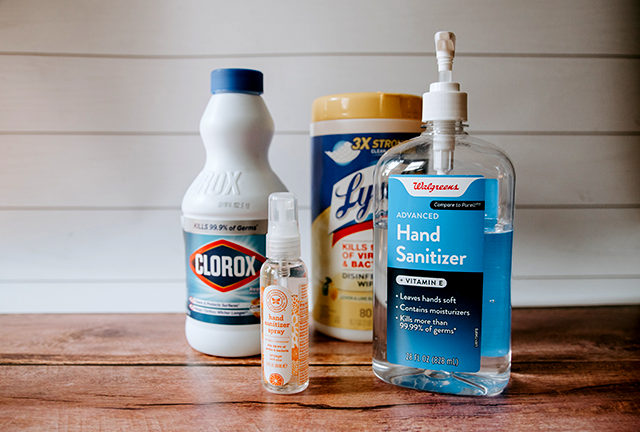Calls to U.S. poison control centers for poisonings related to disinfectants and other cleaning products rose dramatically during the first three months of this year, according to a report released this week by the Centers for Disease Control and Prevention (CDC).
Although the authors of the report acknowledge that a direct link between the increase in calls and the coronavirus pandemic can’t be proven, they say the timing of the increase corresponds to “increased media coverage of the COVID-19 pandemic, reports of consumer shortages of cleaning and disinfection products, and the beginning of some local and state stay-at-home orders.”
The report’s findings are based on data from the National Poison Data System, which collects information on calls made to 55 poison centers across the United States. The CDC researchers added up the number of calls received by those centers for accidental poisonings related to either disinfectants (such as hand sanitizers) or cleaning supplies (such as bleach) during January, February and March 2020. (The first laboratory-confirmed case of COVID-19 in the U.S. was reported in the state of Washington on Jan. 19, 2020.) They then compared that number with the number of calls made during the same periods in 2018 and 2019.
The researchers found that 45,550 calls related to disinfectants and cleaners were recorded by poison control centers during the first three months of this year — 28,158 for cleaners and 17,392 for disinfectants.
That was 20 percent more than the number of calls made in the same period in 2019 and 16 percent more than in 2018.
The calls escalated sharply at the beginning of March 2020, the researchers also found.
Number of daily exposures to cleaners and disinfectants reported to U.S. poison centers — United States, January–March 2018, 2019, and 2020*,†

[image_credit]CDC[/image_credit]
[image_credit]CDC[/image_credit][image_caption]* Excluding February 29, 2020. † Increase in exposures to cleaners on January 29, 2020, came from an unintentional exposure to a cleaning agent within a school.[/image_caption]
The increase in calls to the poison control centers regarding poisonings from disinfectants and cleaners was seen across all age groups, although in 2020, as in past years, the largest share of the incidents involved children aged 5 or younger. Inhalation-related poisonings made up the biggest segment of the increase in calls. Between 2019 and 2020, the number of people calling with possible symptoms of inhaling potentially dangerous fumes from cleaners rose 35 percent for cleaners in general and 109 percent for disinfectants specifically.
Case studies
The CDC report includes two examples of the types of poisoning incidents being reported this year to poison control centers:
Case 1: An adult woman heard on the news to clean all recently purchased groceries before consuming them. She filled a sink with a mixture of 10% bleach solution, vinegar, and hot water, and soaked her produce. While cleaning her other groceries, she noted a noxious smell described as “chlorine” in her kitchen. She developed difficulty breathing, coughing, and wheezing, and called 911. She was transported to the emergency department (ED) via ambulance and was noted to have mild hypoxemia and end-expiratory wheezing. She improved with oxygen and bronchodilators. Her chest radiograph was unremarkable, and she was discharged after a few hours of observation.
Case 2: A preschool-aged child was found unresponsive at home and transported to the ED via ambulance. A 64-ounce bottle of ethanol-based hand sanitizer was found open on the kitchen table. According to her family, she became dizzy after ingesting an unknown amount, fell and hit her head. She vomited while being transported to the ED, where she was poorly responsive. Her blood alcohol level was elevated at 273 mg/dL (most state laws define a limit of 80 mg/dL for driving under the influence); neuroimaging did not indicate traumatic injuries. She was admitted to the pediatric intensive care unit overnight, had improved mental status, and was discharged home after 48 hours.
What consumers should do
The CDC researchers cite several reasons for why people become poisoned by disinfectants and other cleaning products: They use the products improperly (in amounts above what is recommended on the label, for example). They mix two or more products together (such as ammonia and bleach), which can cause a potentially dangerous chemical reaction. They don’t wear protective gear. And they use the products in poorly ventilated areas.
To reduce poisonings from disinfectants and other cleaners, the researchers recommend that all of us take the following precautions:
- Always read and follow the directions on a product’s label.
- When diluting a cleaning product, only use water at room temperature (unless the label instructs otherwise).
- Don’t mix different cleaning products together.
- Wear eye and skin protectors.
- Make sure there is adequate ventilation when using the products.
- Keep the products out of the reach of children.
FMI: The CDC report was published in the April 20 issue of Morbidity and Mortality Weekly Report (MMWR), where it can be read in full.





